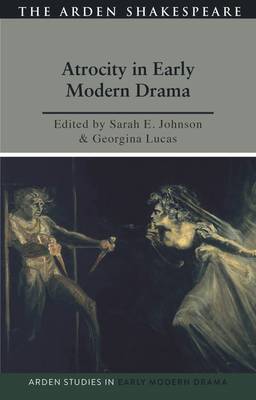
- Afhalen na 1 uur in een winkel met voorraad
- Gratis thuislevering in België vanaf € 30
- Ruim aanbod met 7 miljoen producten
- Afhalen na 1 uur in een winkel met voorraad
- Gratis thuislevering in België vanaf € 30
- Ruim aanbod met 7 miljoen producten
Zoeken
Atrocity and Early Modern Drama
€ 186,95
+ 373 punten
Omschrijving
Extreme violence scarred the early modern period. Contemporary commentators grappled to find language to categorize the massacres, genocides, assassinations, enslavements, sacks, rapes, riots and regicides that characterized the period. Some used 'outrages', others 'cruelties', but, significantly, the term 'atrocity' that we use today gained the most currency.
Atrocity in Early Modern English Drama intervenes in the broad field of violence and early modern drama by placing acts of atrocity at its centre. In doing so, this essay collection offers the first book-length examination of atrocities and early modern English drama. The volume considers atrocity in early theatre, its varied representations in contemporary Shakespeare performance, and strategies for teaching early modern atrocity drama. Contributors introduce us to atrocity in the works of Shakespeare, John Fletcher, William Rowley, Thomas Dekker and Thomas Middleton across a range of forms including comedy, tragedy, revenge, cinematic adaptation, documentary film and contemporary theatre. The collection addresses the intersections of atrocities through class, crime, gender, race and the natural world. Together, the chapters interrogate how early modern English drama reflects upon and shapes understandings of the historically contingent, politically loaded and culturally contentious phenomena of atrocity.
Atrocity in Early Modern English Drama intervenes in the broad field of violence and early modern drama by placing acts of atrocity at its centre. In doing so, this essay collection offers the first book-length examination of atrocities and early modern English drama. The volume considers atrocity in early theatre, its varied representations in contemporary Shakespeare performance, and strategies for teaching early modern atrocity drama. Contributors introduce us to atrocity in the works of Shakespeare, John Fletcher, William Rowley, Thomas Dekker and Thomas Middleton across a range of forms including comedy, tragedy, revenge, cinematic adaptation, documentary film and contemporary theatre. The collection addresses the intersections of atrocities through class, crime, gender, race and the natural world. Together, the chapters interrogate how early modern English drama reflects upon and shapes understandings of the historically contingent, politically loaded and culturally contentious phenomena of atrocity.
Specificaties
Betrokkenen
- Uitgeverij:
Inhoud
- Aantal bladzijden:
- 304
- Taal:
- Engels
- Reeks:
Eigenschappen
- Productcode (EAN):
- 9781350272392
- Verschijningsdatum:
- 23/01/2025
- Uitvoering:
- Hardcover
- Formaat:
- Genaaid
- Afmetingen:
- 140 mm x 216 mm
- Gewicht:
- 489 g

Alleen bij Standaard Boekhandel
+ 373 punten op je klantenkaart van Standaard Boekhandel
Beoordelingen
We publiceren alleen reviews die voldoen aan de voorwaarden voor reviews. Bekijk onze voorwaarden voor reviews.







